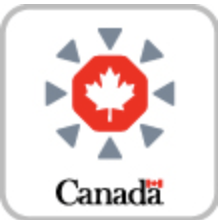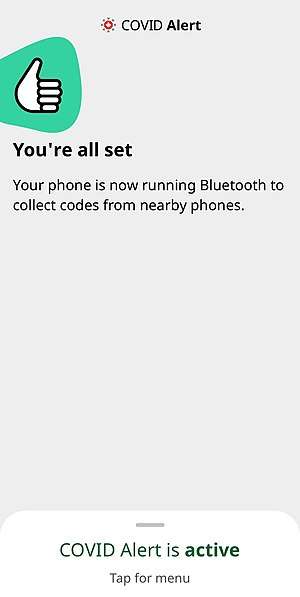COVID Alert
COVID Alert (French: Alerte COVID[5]) is a digital contact tracing mobile app made by the Canadian government as a measure to combat the COVID-19 pandemic in Canada. The app uses Google and Apple Inc.'s Exposure Notification API to notify users if they have come in close contact (less than 2 metres for more than 15 minutes) with someone who has tested positive for COVID-19 in the last 14 days. The app was first announced on 18 June 2020[6] and launched on 31 July 2020 in Ontario.[7]
 | |
Screenshot  | |
| Developer(s) | |
|---|---|
| Initial release | 31 July 2020 |
| Repository | https://github.com/cds-snc/covid-alert-app |
| Operating system | Android, iOS |
| Size | |
| Standard(s) | Exposure Notification[4] |
| Available in | English, French |
| Type | Digital contact tracing |
| Website | www |
As of 13 August, 1.9 million Canadians have downloaded the app, however it is impossible to know how effective it has been.[8]
Features
COVID Alert has very few features on the actual app. Unlike other apps like Aarogya Setu and COVID Tracker, with features such as Self Assess, Your Status (likelihood of getting COVID), and COVID Updates,[9] COVID Alert has no features other than Exposure Notification.
History
On 18 June 2020, Prime Minister Justin Trudeau announced that there was to be a new app which would be made by Shopify, BlackBerry and the Canadian Digital Service, beginning in Ontario and to launch on 2 July.[10]
On 2 July, it was announced that the app was delayed without a reason and it is still unknown why it was delayed.[11]
On 23 July, the Canadian Digital Service requested beta testers to join the app.[12]
On 31 July, Prime Minister Trudeau announced that the app had been launched on the App Store and the Play Store. While it will originally only work in Ontario, the Prime Minister said that the government is attempting to get the Atlantic provinces on first, then other provinces, eventually to a nationwide roll-out.[7]
Privacy
According to the privacy commissioners of both Ontario and the federal government, COVID Alert is very private, due to the app being highly decentralized. According to the government, no identifiable information about the user is revealed, and all data is deleted after 14 days. As well, someone who tests positive for COVID-19 isn't required to put the codes into the app if they do not wish.[13]
The whole code for the app as well as the base of the app (COVID Shield) is open sourced on GitHub, which allows privacy experts and computer scientists to read the code to make sure that there isn't any extra privacy concerns.[14]
Concerns
Privacy
A large number of Canadians are hesitant to download the app, according to a poll from Mobile Syrup.[15] According to the poll, 41% of people who wouldn't immediately install the app said the reason was due to privacy concerns.
Meanwhile, only 30% of Canadians said they would be "very likely" to install the app, compared to 30% saying they were "highly unlikely" to download the app.
As well, some privacy experts were worried that the government would centralize too much information, including Citizen Lab, based at the University of Toronto.[16] However these concerns were raised in May - before COVID Alert was announced - so it is unclear whether they still have the same concerns.
Older phones
A number of people have raised concerns how iPhones which are 5 years are not compatible with COVID Alert.[17] However, the reason is that for better privacy, a special API was needed, and Apple blocks phones which are 5 years or older from upgrading.
See also
References
- Canada, Public Health Agency of (2020-07-31). "COVID Alert: Exposure notification application privacy assessment". aem. Retrieved 2020-08-01.
- "COVID Alert - Apps on Google Play". play.google.com. Retrieved 2020-08-01.
- "COVID Alert". App Store. Retrieved 2020-08-01.
- Miller, Chance (2020-07-31). "COVID Alert app, built with Apple and Google Exposure Notification API, now available in Canada". 9to5Mac. Retrieved 2020-08-01.
- "Téléchargez Alerte COVID dès maintenant". aem. 2020-07-31. Retrieved 2020-08-01.
- Tunney, Catharine (2020-06-18). "Voluntary nationwide contact tracing app coming soon, says Trudeau". CBC News. Retrieved 2020-08-01.
- Thompson, Elizabeth (2020-07-31). "New COVID-19 notification app rolls out in Ontario". CBC News. Retrieved 2020-08-01.
- "The COVID Alert app has been downloaded nearly 2 million times". MobileSyrup. 2020-08-13. Retrieved 2020-08-14.
- "Aarogya Setu App Download: Features,Details,Benefits,Review | SA News". S A NEWS. 2020-04-15. Retrieved 2020-08-02.
- "Coronavirus: Ontario piloting new COVID-19 contact tracing app, launch expected July 2". Global News. Retrieved 2020-08-02.
- "Coronavirus: Launch of COVID-19 contact tracing app in Ontario delayed". Global News. Retrieved 2020-08-02.
- "COVID-19 tracing app starts beta testing after three-week delay". CBC News. Canadian Press. 2020-07-23. Retrieved 2020-08-01.
- Canada, Public Health Agency of (2020-07-31). "COVID Alert Privacy Notice (Exposure Notification)". aem. Retrieved 2020-08-02.
- "Federally-backed COVID alert app now available in Ontario". Ottawa. 2020-07-31. Retrieved 2020-08-02.
- "Only 29 percent of Canadians are 'very likely' to download COVID Alert app: survey". MobileSyrup. 2020-07-24. Retrieved 2020-08-02.
- "Where is the COVID-19 contact tracing app that was supposed to launch in Ontario?". Toronto. 2020-07-20. Retrieved 2020-08-02.
- "Can't download the COVID Alert app? Your operating system may be too old (or new)". Global News. Retrieved 2020-08-14.